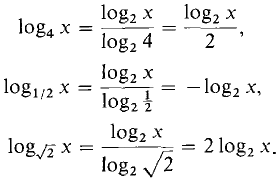| The ebook Elementary Calculus is based on material originally written by H.J. Keisler. For more information please read the copyright pages. |

|

Home  Exponential and Logartihmic Functions Exponential and Logartihmic Functions  Logarithmic Functions Logarithmic Functions  Rules For Changing Bases Of Logarithms Rules For Changing Bases Of Logarithms |
||||||||||||||||||||||||||||||||||||||||||||||






|
||||||||||||||||||||||||||||||||||||||||||||||
Rules For Changing Bases Of Logarithms
There is a simple relationship between logarithms with two different bases. RULES FOR CHANGING BASES OF LOGARITHMS Let a, b, and y be positive and a,b ≠ 1. Then
PROOF a]°sab = b, so
whence Setting a = y we get the equation logb a = 1/(loga b). If we hold the bases a and b fixed and let y vary, then the rule shows that loga y and logb y are proportional to each other, with the constant ratio
Therefore a slide rule based on logarithms to the base 2, for example, would look exactly like a slide rule based on logarithms to the base 10 (common logarithms). If the same unit of length is used, all the distances would be multiplied by the constant factor
So the slide rule would be similar but more than 3 times as big. Table 8.2.1 shows various logarithms with different bases. Table 8.2.1
Notice that for all x > 0,
Also, for each base a, loga (1/x) = -loga x. 
|
||||||||||||||||||||||||||||||||||||||||||||||
Home  Exponential and Logartihmic Functions Exponential and Logartihmic Functions  Logarithmic Functions Logarithmic Functions  Rules For Changing Bases Of Logarithms Rules For Changing Bases Of Logarithms |
||||||||||||||||||||||||||||||||||||||||||||||
Last Update: 2006-11-08








